Accounting Project Task 1: Financial Statements and Analysis
VerifiedAdded on 2020/06/04
|13
|2471
|179
Project
AI Summary
This accounting project delves into fundamental concepts and practical applications within the field. It begins by defining plagiarism and then explores methods for incorporating spreadsheets into documents. The project examines accounting websites and their relevance, professional accounting bodies, and work-integrated assessments. A significant portion analyzes the ABC learning case study, outlining major financial reports, summarizing key lessons, and discussing ethical issues. Practical exercises include creating a manual balance sheet and equation, developing spreadsheet solutions, and listing debit and credit accounts. The project also covers trial balances, adjusting entries, current and non-current liabilities, and the current ratio. Finally, it presents a financial report and includes references. The project incorporates both manual and spreadsheet solutions for key accounting tasks, providing a comprehensive understanding of financial accounting principles and their application in real-world scenarios. The document covers various accounting topics and provides examples, solutions, and explanations related to financial reporting, ethics, and practical exercises. The assignment highlights the importance of understanding financial statements, ethical considerations, and practical exercises.
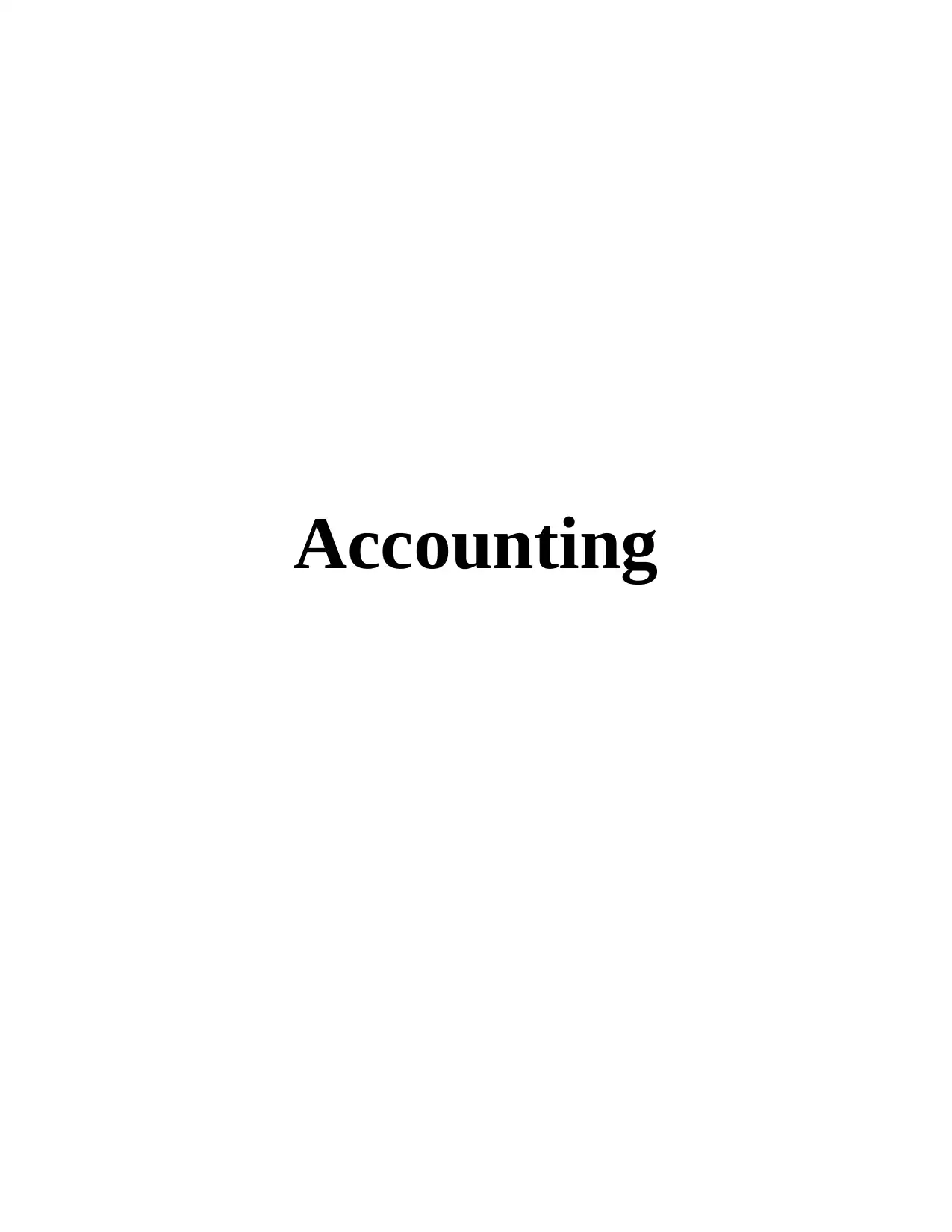
Accounting
Paraphrase This Document
Need a fresh take? Get an instant paraphrase of this document with our AI Paraphraser
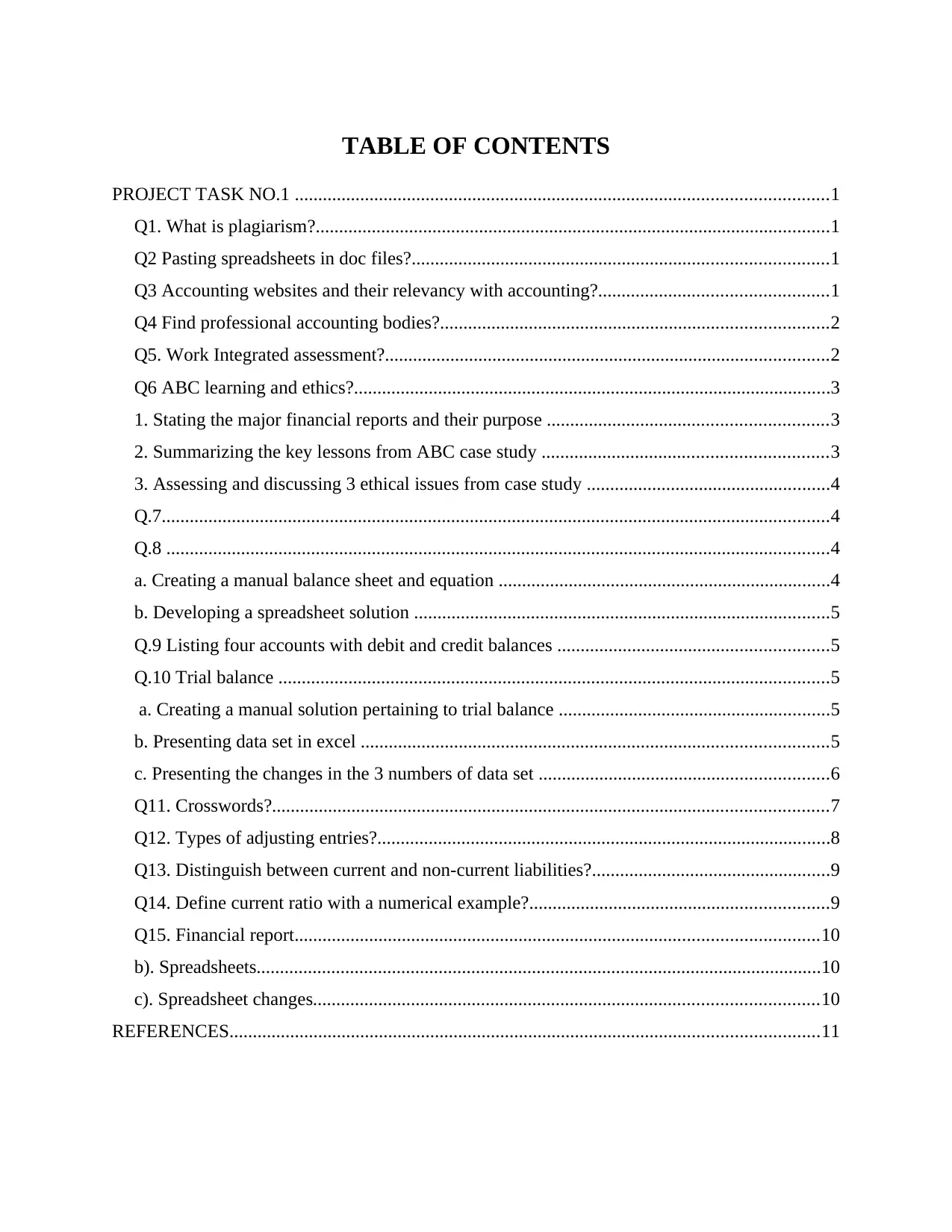
TABLE OF CONTENTS
PROJECT TASK NO.1 ..................................................................................................................1
Q1. What is plagiarism?..............................................................................................................1
Q2 Pasting spreadsheets in doc files?.........................................................................................1
Q3 Accounting websites and their relevancy with accounting?.................................................1
Q4 Find professional accounting bodies?...................................................................................2
Q5. Work Integrated assessment?...............................................................................................2
Q6 ABC learning and ethics?......................................................................................................3
1. Stating the major financial reports and their purpose ............................................................3
2. Summarizing the key lessons from ABC case study .............................................................3
3. Assessing and discussing 3 ethical issues from case study ....................................................4
Q.7...............................................................................................................................................4
Q.8 ..............................................................................................................................................4
a. Creating a manual balance sheet and equation .......................................................................4
b. Developing a spreadsheet solution .........................................................................................5
Q.9 Listing four accounts with debit and credit balances ..........................................................5
Q.10 Trial balance ......................................................................................................................5
a. Creating a manual solution pertaining to trial balance ..........................................................5
b. Presenting data set in excel ....................................................................................................5
c. Presenting the changes in the 3 numbers of data set ..............................................................6
Q11. Crosswords?.......................................................................................................................7
Q12. Types of adjusting entries?.................................................................................................8
Q13. Distinguish between current and non-current liabilities?...................................................9
Q14. Define current ratio with a numerical example?................................................................9
Q15. Financial report................................................................................................................10
b). Spreadsheets.........................................................................................................................10
c). Spreadsheet changes............................................................................................................10
REFERENCES..............................................................................................................................11
PROJECT TASK NO.1 ..................................................................................................................1
Q1. What is plagiarism?..............................................................................................................1
Q2 Pasting spreadsheets in doc files?.........................................................................................1
Q3 Accounting websites and their relevancy with accounting?.................................................1
Q4 Find professional accounting bodies?...................................................................................2
Q5. Work Integrated assessment?...............................................................................................2
Q6 ABC learning and ethics?......................................................................................................3
1. Stating the major financial reports and their purpose ............................................................3
2. Summarizing the key lessons from ABC case study .............................................................3
3. Assessing and discussing 3 ethical issues from case study ....................................................4
Q.7...............................................................................................................................................4
Q.8 ..............................................................................................................................................4
a. Creating a manual balance sheet and equation .......................................................................4
b. Developing a spreadsheet solution .........................................................................................5
Q.9 Listing four accounts with debit and credit balances ..........................................................5
Q.10 Trial balance ......................................................................................................................5
a. Creating a manual solution pertaining to trial balance ..........................................................5
b. Presenting data set in excel ....................................................................................................5
c. Presenting the changes in the 3 numbers of data set ..............................................................6
Q11. Crosswords?.......................................................................................................................7
Q12. Types of adjusting entries?.................................................................................................8
Q13. Distinguish between current and non-current liabilities?...................................................9
Q14. Define current ratio with a numerical example?................................................................9
Q15. Financial report................................................................................................................10
b). Spreadsheets.........................................................................................................................10
c). Spreadsheet changes............................................................................................................10
REFERENCES..............................................................................................................................11
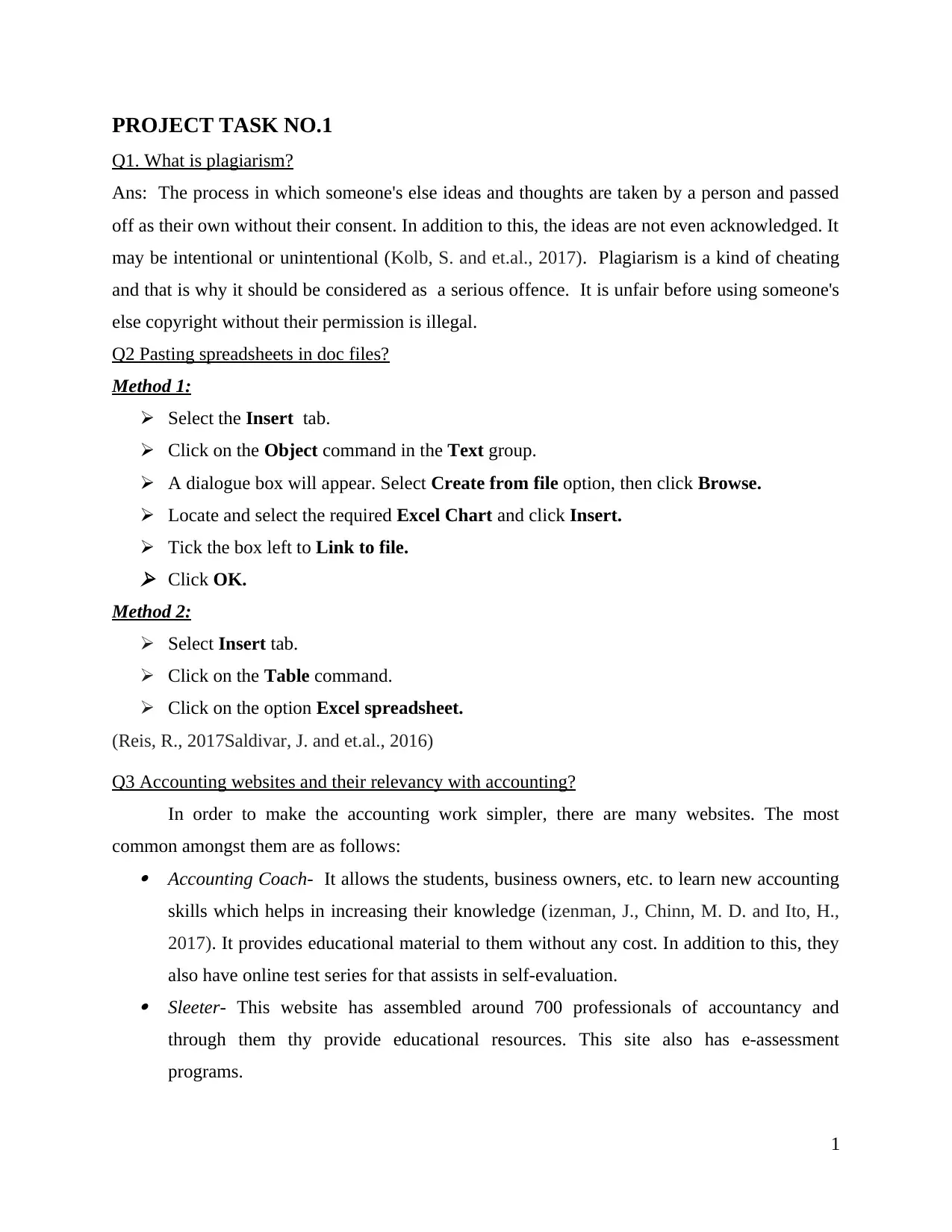
PROJECT TASK NO.1
Q1. What is plagiarism?
Ans: The process in which someone's else ideas and thoughts are taken by a person and passed
off as their own without their consent. In addition to this, the ideas are not even acknowledged. It
may be intentional or unintentional (Kolb, S. and et.al., 2017). Plagiarism is a kind of cheating
and that is why it should be considered as a serious offence. It is unfair before using someone's
else copyright without their permission is illegal.
Q2 Pasting spreadsheets in doc files?
Method 1:
Select the Insert tab.
Click on the Object command in the Text group.
A dialogue box will appear. Select Create from file option, then click Browse.
Locate and select the required Excel Chart and click Insert.
Tick the box left to Link to file. Click OK.
Method 2:
Select Insert tab.
Click on the Table command.
Click on the option Excel spreadsheet.
(Reis, R., 2017Saldivar, J. and et.al., 2016)
Q3 Accounting websites and their relevancy with accounting?
In order to make the accounting work simpler, there are many websites. The most
common amongst them are as follows: Accounting Coach- It allows the students, business owners, etc. to learn new accounting
skills which helps in increasing their knowledge (izenman, J., Chinn, M. D. and Ito, H.,
2017). It provides educational material to them without any cost. In addition to this, they
also have online test series for that assists in self-evaluation. Sleeter- This website has assembled around 700 professionals of accountancy and
through them thy provide educational resources. This site also has e-assessment
programs.
1
Q1. What is plagiarism?
Ans: The process in which someone's else ideas and thoughts are taken by a person and passed
off as their own without their consent. In addition to this, the ideas are not even acknowledged. It
may be intentional or unintentional (Kolb, S. and et.al., 2017). Plagiarism is a kind of cheating
and that is why it should be considered as a serious offence. It is unfair before using someone's
else copyright without their permission is illegal.
Q2 Pasting spreadsheets in doc files?
Method 1:
Select the Insert tab.
Click on the Object command in the Text group.
A dialogue box will appear. Select Create from file option, then click Browse.
Locate and select the required Excel Chart and click Insert.
Tick the box left to Link to file. Click OK.
Method 2:
Select Insert tab.
Click on the Table command.
Click on the option Excel spreadsheet.
(Reis, R., 2017Saldivar, J. and et.al., 2016)
Q3 Accounting websites and their relevancy with accounting?
In order to make the accounting work simpler, there are many websites. The most
common amongst them are as follows: Accounting Coach- It allows the students, business owners, etc. to learn new accounting
skills which helps in increasing their knowledge (izenman, J., Chinn, M. D. and Ito, H.,
2017). It provides educational material to them without any cost. In addition to this, they
also have online test series for that assists in self-evaluation. Sleeter- This website has assembled around 700 professionals of accountancy and
through them thy provide educational resources. This site also has e-assessment
programs.
1
⊘ This is a preview!⊘
Do you want full access?
Subscribe today to unlock all pages.

Trusted by 1+ million students worldwide
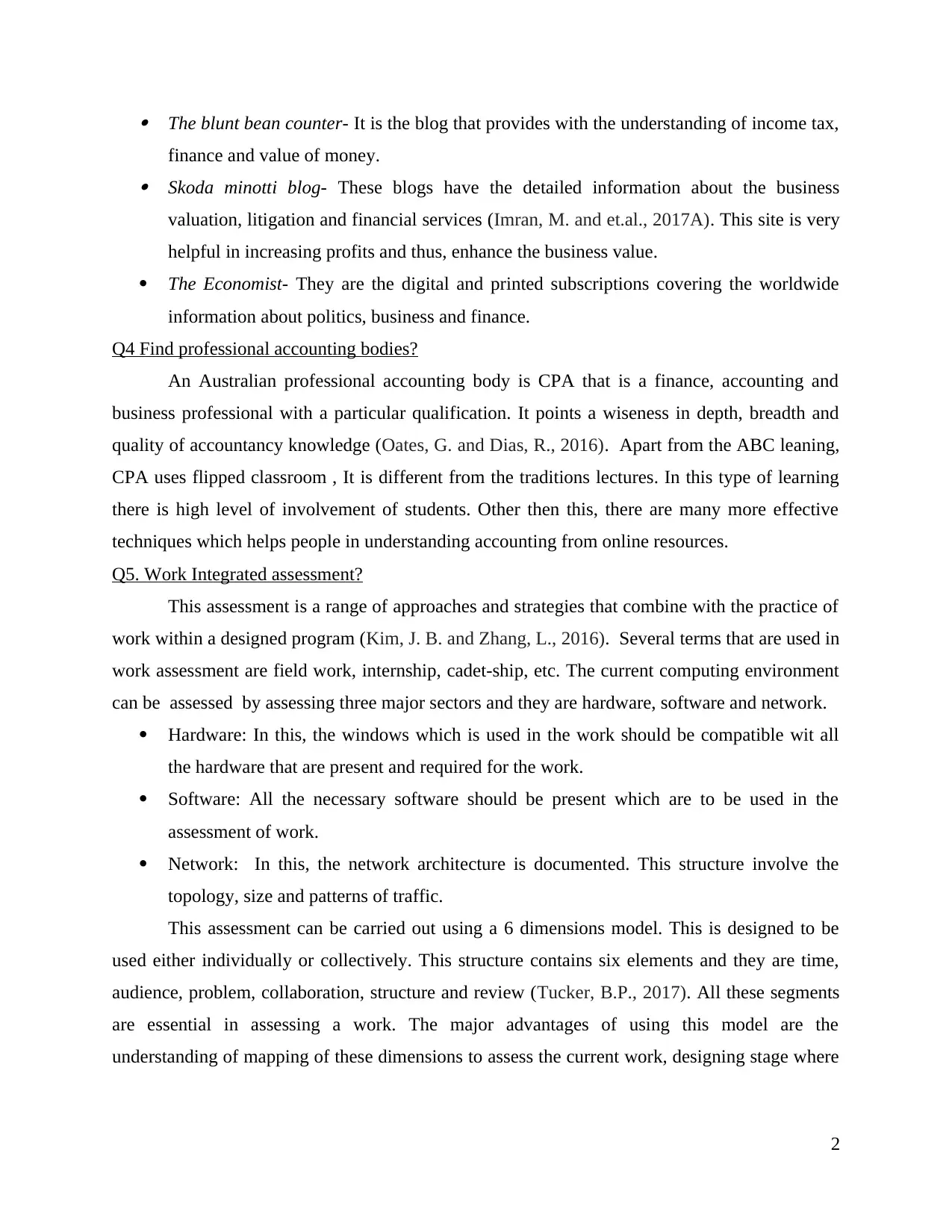
The blunt bean counter- It is the blog that provides with the understanding of income tax,
finance and value of money. Skoda minotti blog- These blogs have the detailed information about the business
valuation, litigation and financial services (Imran, M. and et.al., 2017A). This site is very
helpful in increasing profits and thus, enhance the business value.
The Economist- They are the digital and printed subscriptions covering the worldwide
information about politics, business and finance.
Q4 Find professional accounting bodies?
An Australian professional accounting body is CPA that is a finance, accounting and
business professional with a particular qualification. It points a wiseness in depth, breadth and
quality of accountancy knowledge (Oates, G. and Dias, R., 2016). Apart from the ABC leaning,
CPA uses flipped classroom , It is different from the traditions lectures. In this type of learning
there is high level of involvement of students. Other then this, there are many more effective
techniques which helps people in understanding accounting from online resources.
Q5. Work Integrated assessment?
This assessment is a range of approaches and strategies that combine with the practice of
work within a designed program (Kim, J. B. and Zhang, L., 2016). Several terms that are used in
work assessment are field work, internship, cadet-ship, etc. The current computing environment
can be assessed by assessing three major sectors and they are hardware, software and network.
Hardware: In this, the windows which is used in the work should be compatible wit all
the hardware that are present and required for the work.
Software: All the necessary software should be present which are to be used in the
assessment of work.
Network: In this, the network architecture is documented. This structure involve the
topology, size and patterns of traffic.
This assessment can be carried out using a 6 dimensions model. This is designed to be
used either individually or collectively. This structure contains six elements and they are time,
audience, problem, collaboration, structure and review (Tucker, B.P., 2017). All these segments
are essential in assessing a work. The major advantages of using this model are the
understanding of mapping of these dimensions to assess the current work, designing stage where
2
finance and value of money. Skoda minotti blog- These blogs have the detailed information about the business
valuation, litigation and financial services (Imran, M. and et.al., 2017A). This site is very
helpful in increasing profits and thus, enhance the business value.
The Economist- They are the digital and printed subscriptions covering the worldwide
information about politics, business and finance.
Q4 Find professional accounting bodies?
An Australian professional accounting body is CPA that is a finance, accounting and
business professional with a particular qualification. It points a wiseness in depth, breadth and
quality of accountancy knowledge (Oates, G. and Dias, R., 2016). Apart from the ABC leaning,
CPA uses flipped classroom , It is different from the traditions lectures. In this type of learning
there is high level of involvement of students. Other then this, there are many more effective
techniques which helps people in understanding accounting from online resources.
Q5. Work Integrated assessment?
This assessment is a range of approaches and strategies that combine with the practice of
work within a designed program (Kim, J. B. and Zhang, L., 2016). Several terms that are used in
work assessment are field work, internship, cadet-ship, etc. The current computing environment
can be assessed by assessing three major sectors and they are hardware, software and network.
Hardware: In this, the windows which is used in the work should be compatible wit all
the hardware that are present and required for the work.
Software: All the necessary software should be present which are to be used in the
assessment of work.
Network: In this, the network architecture is documented. This structure involve the
topology, size and patterns of traffic.
This assessment can be carried out using a 6 dimensions model. This is designed to be
used either individually or collectively. This structure contains six elements and they are time,
audience, problem, collaboration, structure and review (Tucker, B.P., 2017). All these segments
are essential in assessing a work. The major advantages of using this model are the
understanding of mapping of these dimensions to assess the current work, designing stage where
2
Paraphrase This Document
Need a fresh take? Get an instant paraphrase of this document with our AI Paraphraser
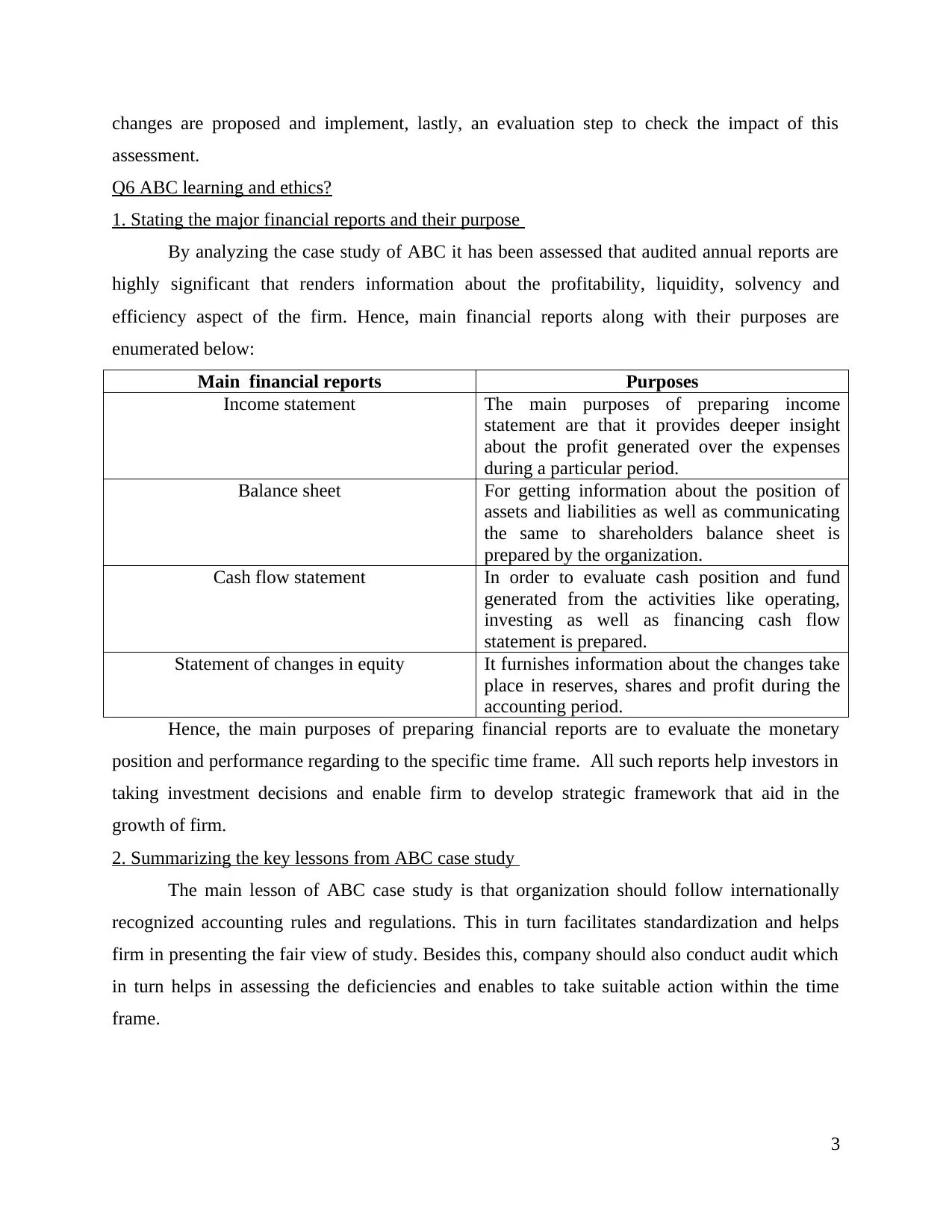
changes are proposed and implement, lastly, an evaluation step to check the impact of this
assessment.
Q6 ABC learning and ethics?
1. Stating the major financial reports and their purpose
By analyzing the case study of ABC it has been assessed that audited annual reports are
highly significant that renders information about the profitability, liquidity, solvency and
efficiency aspect of the firm. Hence, main financial reports along with their purposes are
enumerated below:
Main financial reports Purposes
Income statement The main purposes of preparing income
statement are that it provides deeper insight
about the profit generated over the expenses
during a particular period.
Balance sheet For getting information about the position of
assets and liabilities as well as communicating
the same to shareholders balance sheet is
prepared by the organization.
Cash flow statement In order to evaluate cash position and fund
generated from the activities like operating,
investing as well as financing cash flow
statement is prepared.
Statement of changes in equity It furnishes information about the changes take
place in reserves, shares and profit during the
accounting period.
Hence, the main purposes of preparing financial reports are to evaluate the monetary
position and performance regarding to the specific time frame. All such reports help investors in
taking investment decisions and enable firm to develop strategic framework that aid in the
growth of firm.
2. Summarizing the key lessons from ABC case study
The main lesson of ABC case study is that organization should follow internationally
recognized accounting rules and regulations. This in turn facilitates standardization and helps
firm in presenting the fair view of study. Besides this, company should also conduct audit which
in turn helps in assessing the deficiencies and enables to take suitable action within the time
frame.
3
assessment.
Q6 ABC learning and ethics?
1. Stating the major financial reports and their purpose
By analyzing the case study of ABC it has been assessed that audited annual reports are
highly significant that renders information about the profitability, liquidity, solvency and
efficiency aspect of the firm. Hence, main financial reports along with their purposes are
enumerated below:
Main financial reports Purposes
Income statement The main purposes of preparing income
statement are that it provides deeper insight
about the profit generated over the expenses
during a particular period.
Balance sheet For getting information about the position of
assets and liabilities as well as communicating
the same to shareholders balance sheet is
prepared by the organization.
Cash flow statement In order to evaluate cash position and fund
generated from the activities like operating,
investing as well as financing cash flow
statement is prepared.
Statement of changes in equity It furnishes information about the changes take
place in reserves, shares and profit during the
accounting period.
Hence, the main purposes of preparing financial reports are to evaluate the monetary
position and performance regarding to the specific time frame. All such reports help investors in
taking investment decisions and enable firm to develop strategic framework that aid in the
growth of firm.
2. Summarizing the key lessons from ABC case study
The main lesson of ABC case study is that organization should follow internationally
recognized accounting rules and regulations. This in turn facilitates standardization and helps
firm in presenting the fair view of study. Besides this, company should also conduct audit which
in turn helps in assessing the deficiencies and enables to take suitable action within the time
frame.
3
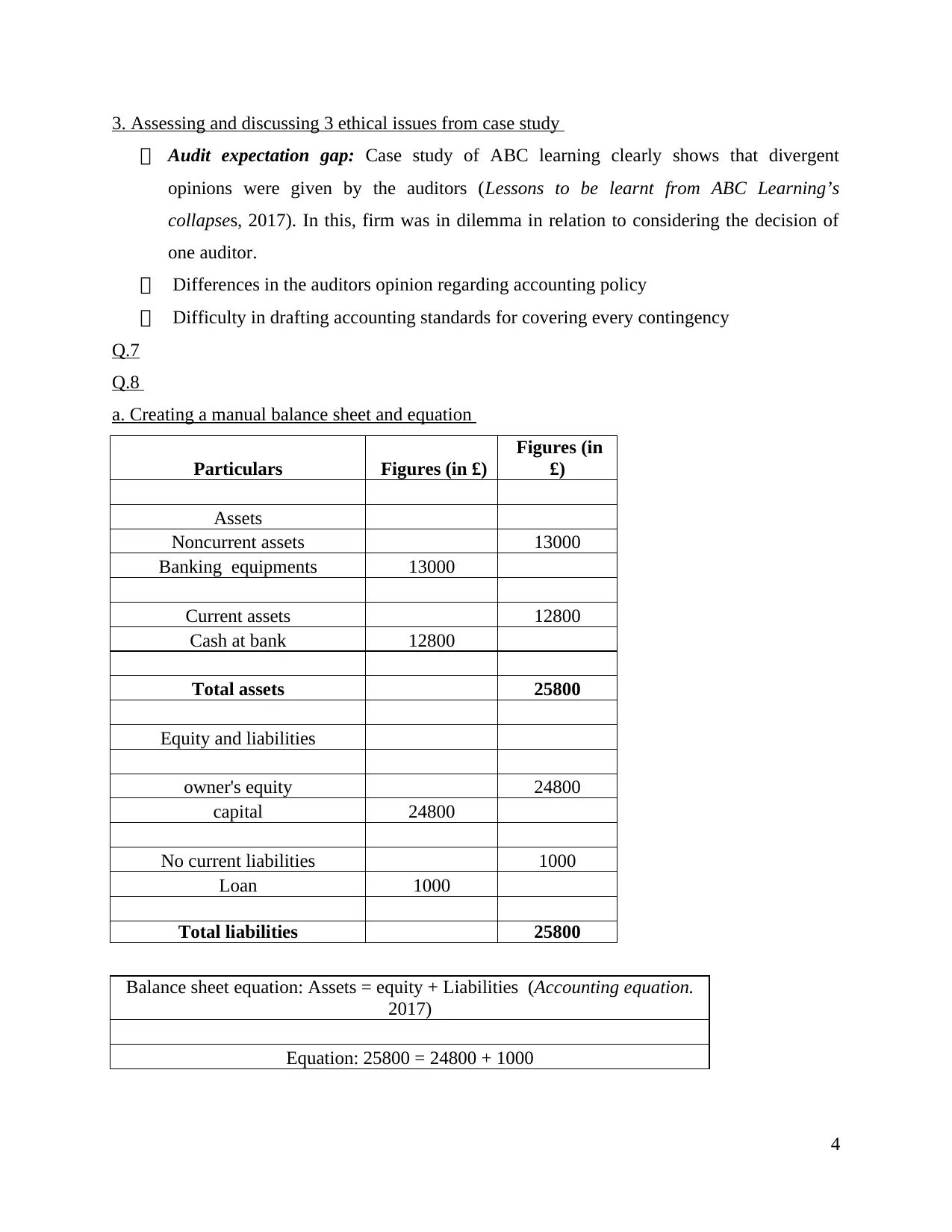
3. Assessing and discussing 3 ethical issues from case study
Audit expectation gap: Case study of ABC learning clearly shows that divergent
opinions were given by the auditors (Lessons to be learnt from ABC Learning’s
collapses, 2017). In this, firm was in dilemma in relation to considering the decision of
one auditor.
Differences in the auditors opinion regarding accounting policy
Difficulty in drafting accounting standards for covering every contingency
Q.7
Q.8
a. Creating a manual balance sheet and equation
Particulars Figures (in £)
Figures (in
£)
Assets
Noncurrent assets 13000
Banking equipments 13000
Current assets 12800
Cash at bank 12800
Total assets 25800
Equity and liabilities
owner's equity 24800
capital 24800
No current liabilities 1000
Loan 1000
Total liabilities 25800
Balance sheet equation: Assets = equity + Liabilities (Accounting equation.
2017)
Equation: 25800 = 24800 + 1000
4
Audit expectation gap: Case study of ABC learning clearly shows that divergent
opinions were given by the auditors (Lessons to be learnt from ABC Learning’s
collapses, 2017). In this, firm was in dilemma in relation to considering the decision of
one auditor.
Differences in the auditors opinion regarding accounting policy
Difficulty in drafting accounting standards for covering every contingency
Q.7
Q.8
a. Creating a manual balance sheet and equation
Particulars Figures (in £)
Figures (in
£)
Assets
Noncurrent assets 13000
Banking equipments 13000
Current assets 12800
Cash at bank 12800
Total assets 25800
Equity and liabilities
owner's equity 24800
capital 24800
No current liabilities 1000
Loan 1000
Total liabilities 25800
Balance sheet equation: Assets = equity + Liabilities (Accounting equation.
2017)
Equation: 25800 = 24800 + 1000
4
⊘ This is a preview!⊘
Do you want full access?
Subscribe today to unlock all pages.

Trusted by 1+ million students worldwide
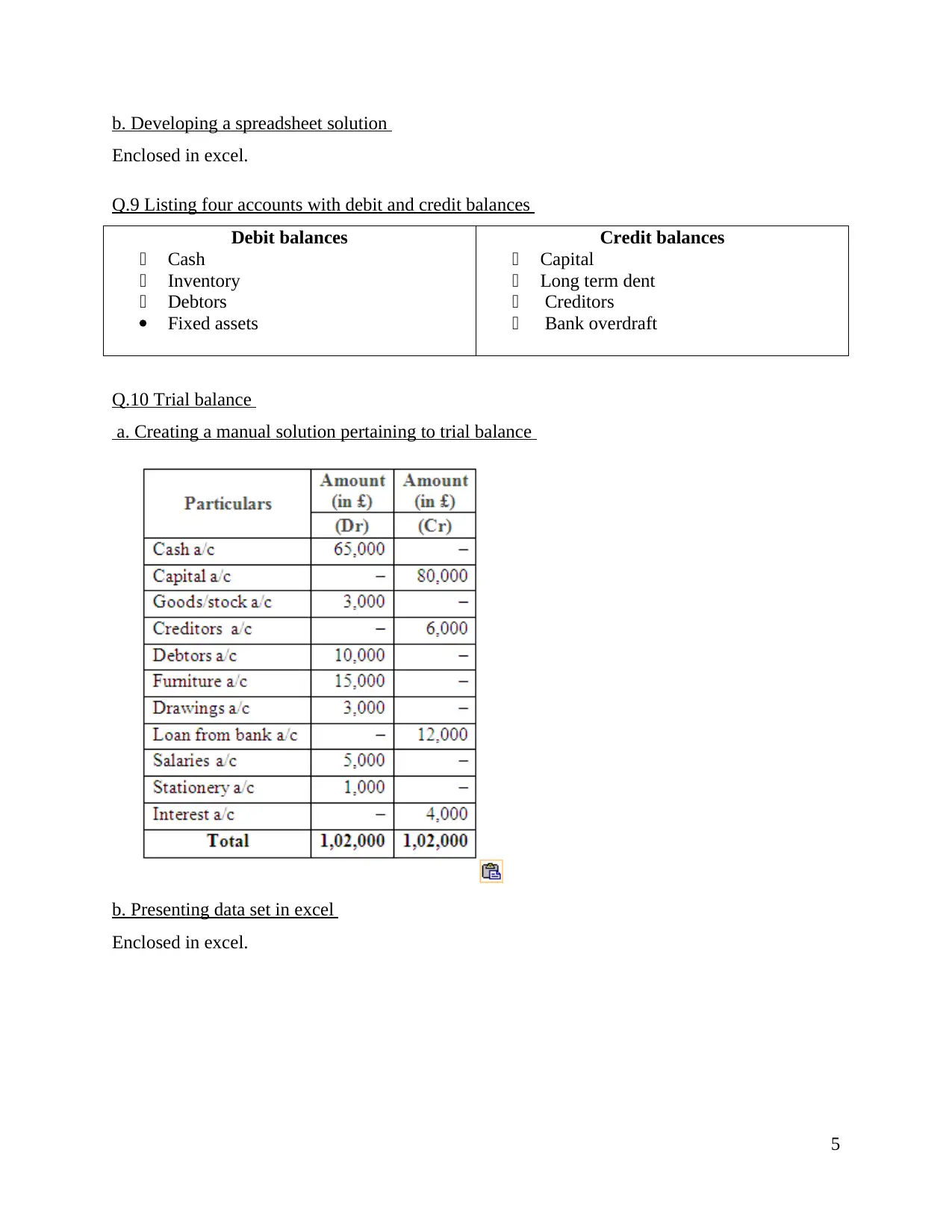
b. Developing a spreadsheet solution
Enclosed in excel.
Q.9 Listing four accounts with debit and credit balances
Debit balances
Cash
Inventory
Debtors
Fixed assets
Credit balances
Capital
Long term dent
Creditors
Bank overdraft
Q.10 Trial balance
a. Creating a manual solution pertaining to trial balance
b. Presenting data set in excel
Enclosed in excel.
5
Enclosed in excel.
Q.9 Listing four accounts with debit and credit balances
Debit balances
Cash
Inventory
Debtors
Fixed assets
Credit balances
Capital
Long term dent
Creditors
Bank overdraft
Q.10 Trial balance
a. Creating a manual solution pertaining to trial balance
b. Presenting data set in excel
Enclosed in excel.
5
Paraphrase This Document
Need a fresh take? Get an instant paraphrase of this document with our AI Paraphraser
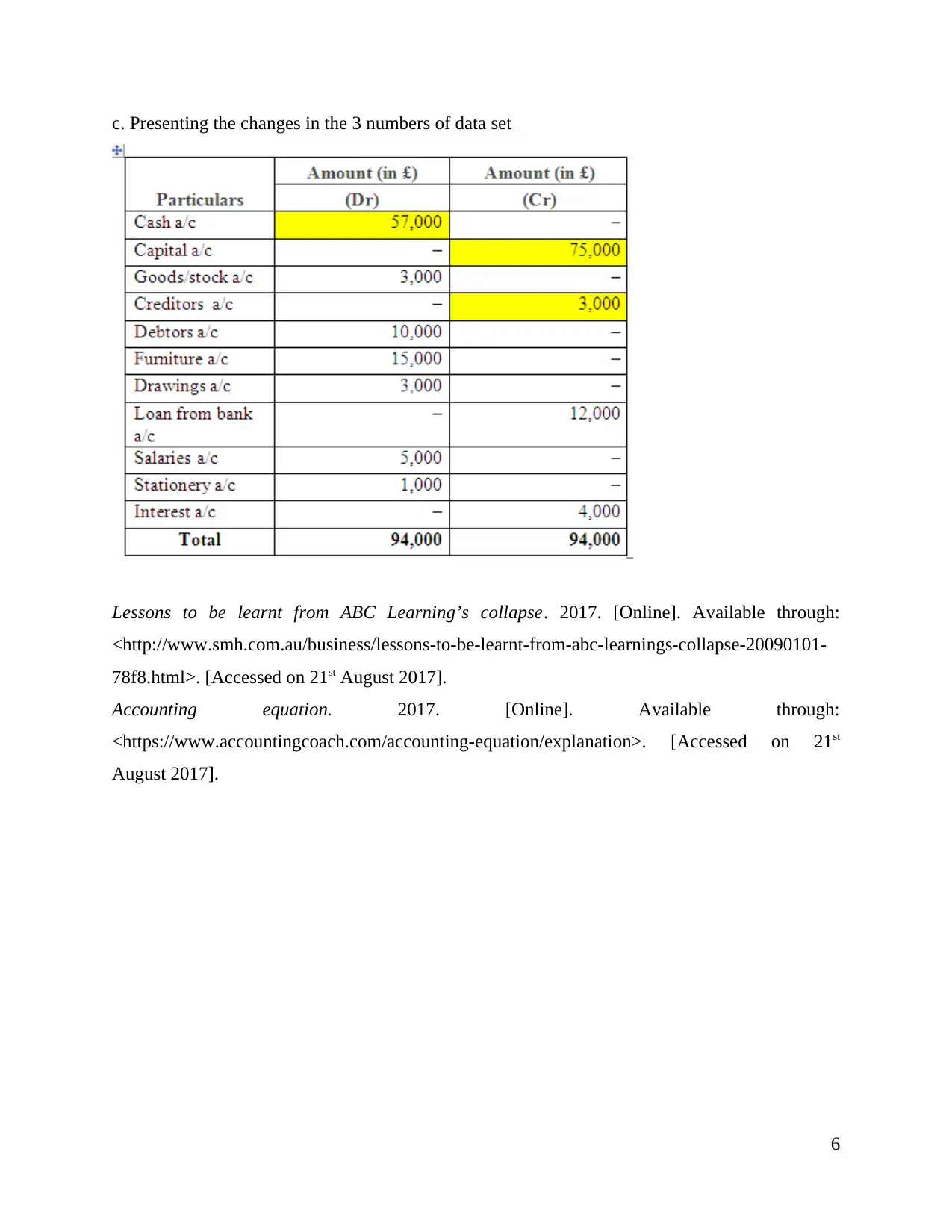
c. Presenting the changes in the 3 numbers of data set
Lessons to be learnt from ABC Learning’s collapse. 2017. [Online]. Available through:
<http://www.smh.com.au/business/lessons-to-be-learnt-from-abc-learnings-collapse-20090101-
78f8.html>. [Accessed on 21st August 2017].
Accounting equation. 2017. [Online]. Available through:
<https://www.accountingcoach.com/accounting-equation/explanation>. [Accessed on 21st
August 2017].
6
Lessons to be learnt from ABC Learning’s collapse. 2017. [Online]. Available through:
<http://www.smh.com.au/business/lessons-to-be-learnt-from-abc-learnings-collapse-20090101-
78f8.html>. [Accessed on 21st August 2017].
Accounting equation. 2017. [Online]. Available through:
<https://www.accountingcoach.com/accounting-equation/explanation>. [Accessed on 21st
August 2017].
6
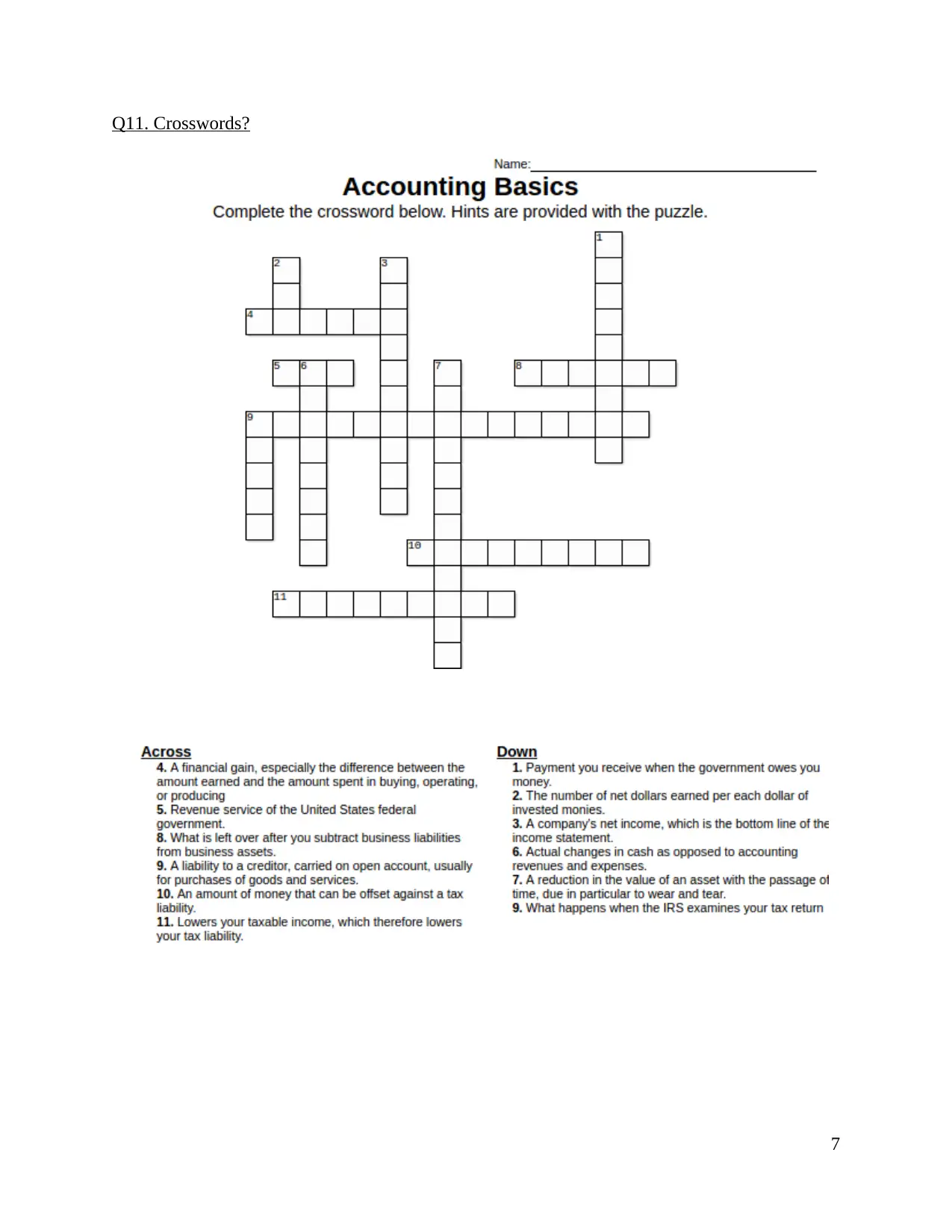
Q11. Crosswords?
7
7
⊘ This is a preview!⊘
Do you want full access?
Subscribe today to unlock all pages.

Trusted by 1+ million students worldwide
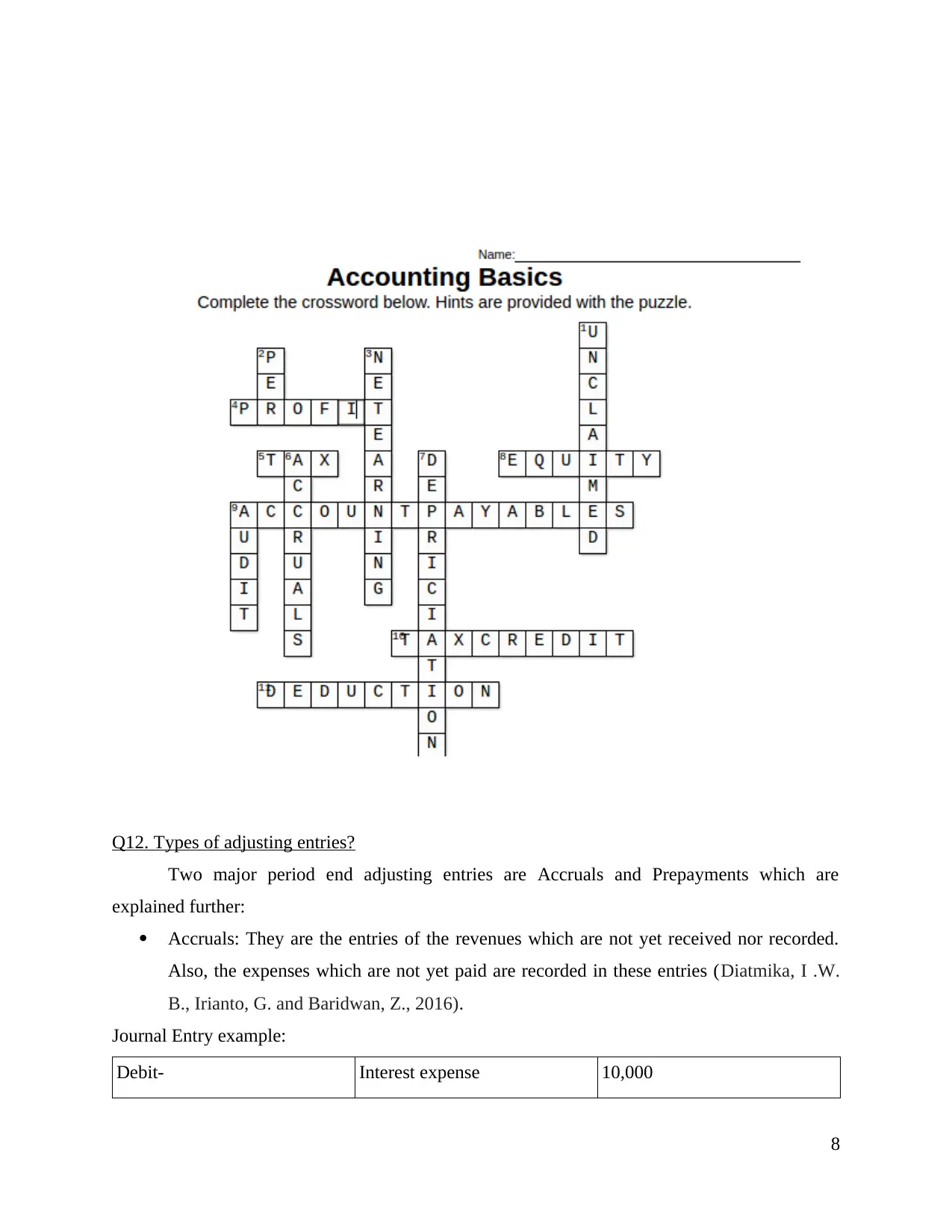
Q12. Types of adjusting entries?
Two major period end adjusting entries are Accruals and Prepayments which are
explained further:
Accruals: They are the entries of the revenues which are not yet received nor recorded.
Also, the expenses which are not yet paid are recorded in these entries (Diatmika, I .W.
B., Irianto, G. and Baridwan, Z., 2016).
Journal Entry example:
Debit- Interest expense 10,000
8
Two major period end adjusting entries are Accruals and Prepayments which are
explained further:
Accruals: They are the entries of the revenues which are not yet received nor recorded.
Also, the expenses which are not yet paid are recorded in these entries (Diatmika, I .W.
B., Irianto, G. and Baridwan, Z., 2016).
Journal Entry example:
Debit- Interest expense 10,000
8
Paraphrase This Document
Need a fresh take? Get an instant paraphrase of this document with our AI Paraphraser
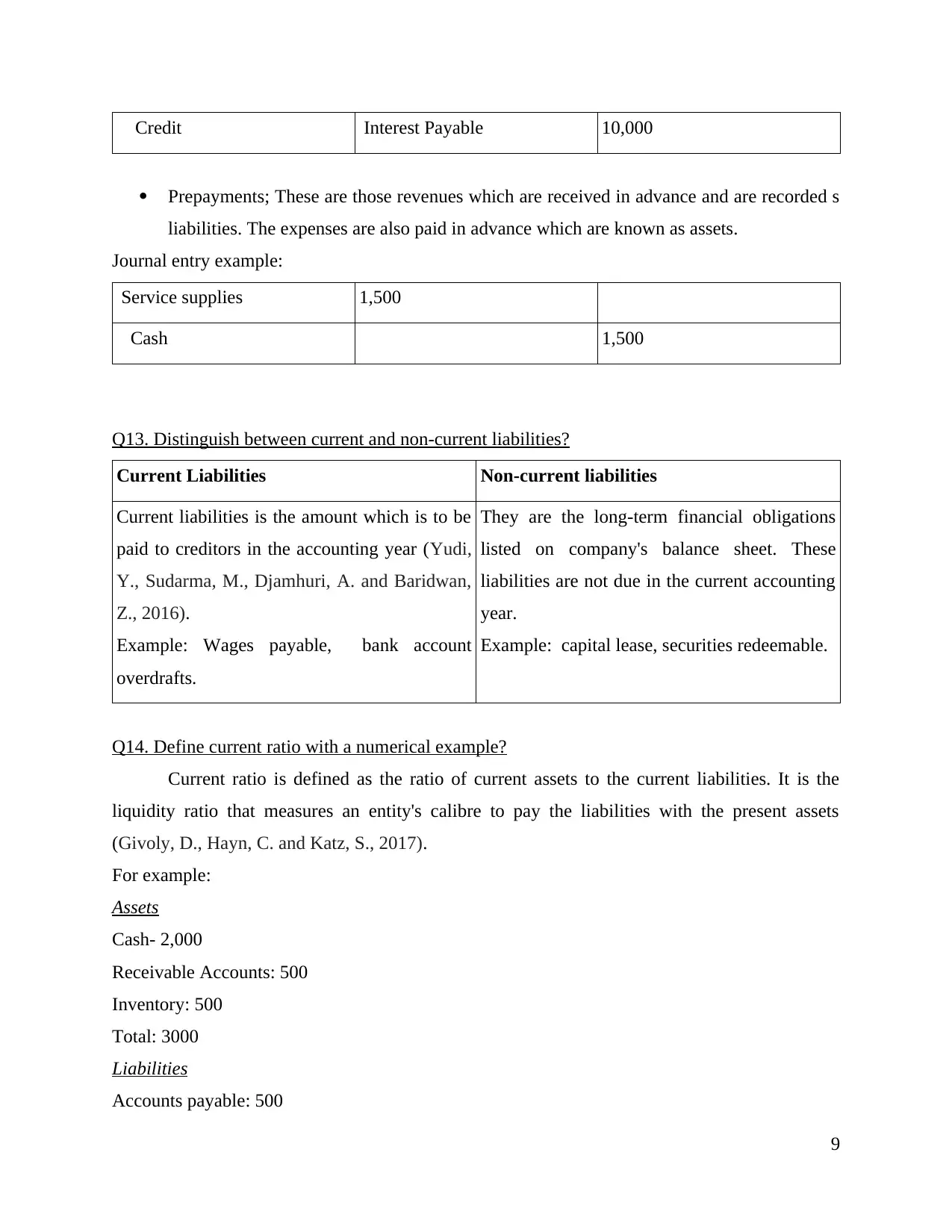
Credit Interest Payable 10,000
Prepayments; These are those revenues which are received in advance and are recorded s
liabilities. The expenses are also paid in advance which are known as assets.
Journal entry example:
Service supplies 1,500
Cash 1,500
Q13. Distinguish between current and non-current liabilities?
Current Liabilities Non-current liabilities
Current liabilities is the amount which is to be
paid to creditors in the accounting year (Yudi,
Y., Sudarma, M., Djamhuri, A. and Baridwan,
Z., 2016).
Example: Wages payable, bank account
overdrafts.
They are the long-term financial obligations
listed on company's balance sheet. These
liabilities are not due in the current accounting
year.
Example: capital lease, securities redeemable.
Q14. Define current ratio with a numerical example?
Current ratio is defined as the ratio of current assets to the current liabilities. It is the
liquidity ratio that measures an entity's calibre to pay the liabilities with the present assets
(Givoly, D., Hayn, C. and Katz, S., 2017).
For example:
Assets
Cash- 2,000
Receivable Accounts: 500
Inventory: 500
Total: 3000
Liabilities
Accounts payable: 500
9
Prepayments; These are those revenues which are received in advance and are recorded s
liabilities. The expenses are also paid in advance which are known as assets.
Journal entry example:
Service supplies 1,500
Cash 1,500
Q13. Distinguish between current and non-current liabilities?
Current Liabilities Non-current liabilities
Current liabilities is the amount which is to be
paid to creditors in the accounting year (Yudi,
Y., Sudarma, M., Djamhuri, A. and Baridwan,
Z., 2016).
Example: Wages payable, bank account
overdrafts.
They are the long-term financial obligations
listed on company's balance sheet. These
liabilities are not due in the current accounting
year.
Example: capital lease, securities redeemable.
Q14. Define current ratio with a numerical example?
Current ratio is defined as the ratio of current assets to the current liabilities. It is the
liquidity ratio that measures an entity's calibre to pay the liabilities with the present assets
(Givoly, D., Hayn, C. and Katz, S., 2017).
For example:
Assets
Cash- 2,000
Receivable Accounts: 500
Inventory: 500
Total: 3000
Liabilities
Accounts payable: 500
9
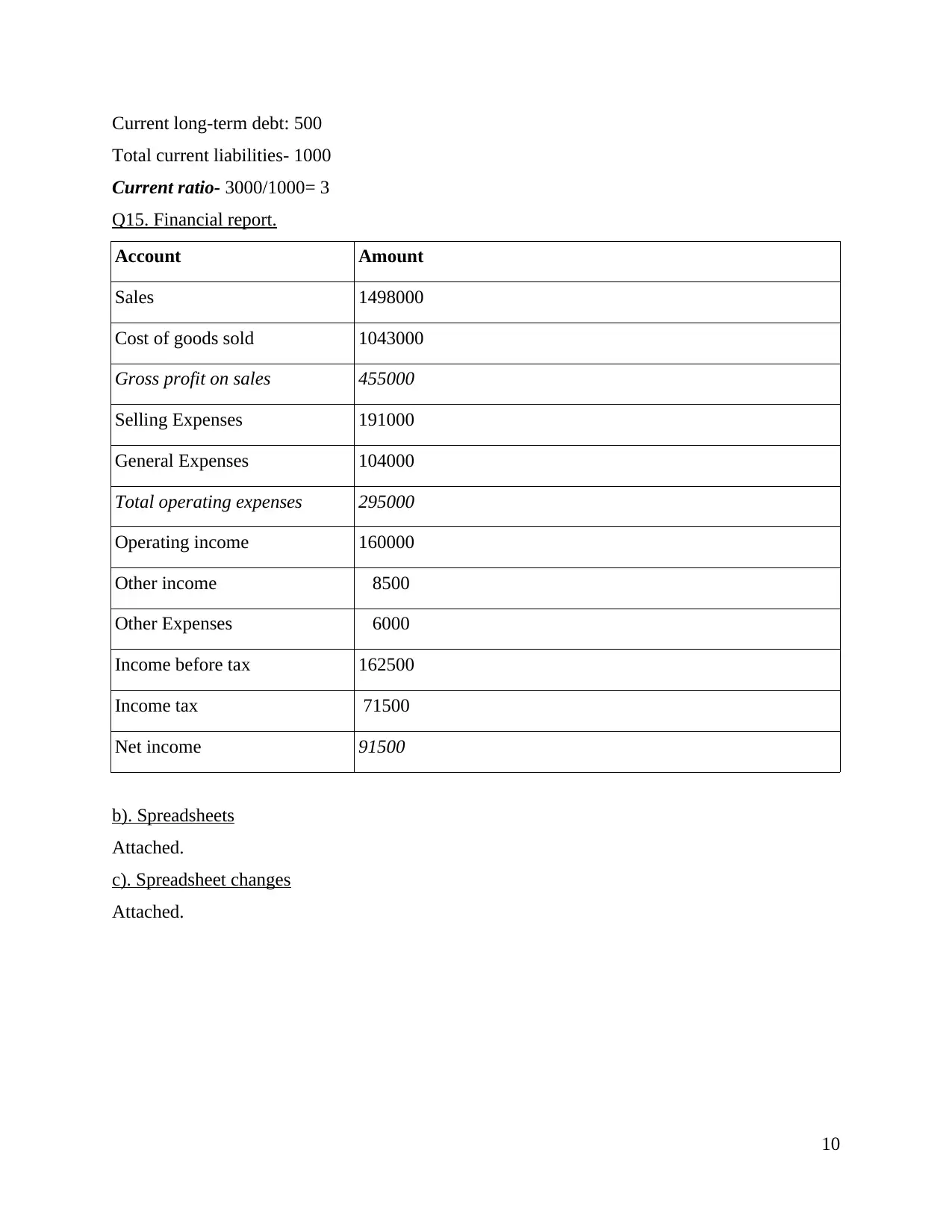
Current long-term debt: 500
Total current liabilities- 1000
Current ratio- 3000/1000= 3
Q15. Financial report.
Account Amount
Sales 1498000
Cost of goods sold 1043000
Gross profit on sales 455000
Selling Expenses 191000
General Expenses 104000
Total operating expenses 295000
Operating income 160000
Other income 8500
Other Expenses 6000
Income before tax 162500
Income tax 71500
Net income 91500
b). Spreadsheets
Attached.
c). Spreadsheet changes
Attached.
10
Total current liabilities- 1000
Current ratio- 3000/1000= 3
Q15. Financial report.
Account Amount
Sales 1498000
Cost of goods sold 1043000
Gross profit on sales 455000
Selling Expenses 191000
General Expenses 104000
Total operating expenses 295000
Operating income 160000
Other income 8500
Other Expenses 6000
Income before tax 162500
Income tax 71500
Net income 91500
b). Spreadsheets
Attached.
c). Spreadsheet changes
Attached.
10
⊘ This is a preview!⊘
Do you want full access?
Subscribe today to unlock all pages.

Trusted by 1+ million students worldwide
1 out of 13
Related Documents
Your All-in-One AI-Powered Toolkit for Academic Success.
+13062052269
info@desklib.com
Available 24*7 on WhatsApp / Email
![[object Object]](/_next/static/media/star-bottom.7253800d.svg)
Unlock your academic potential
Copyright © 2020–2025 A2Z Services. All Rights Reserved. Developed and managed by ZUCOL.





